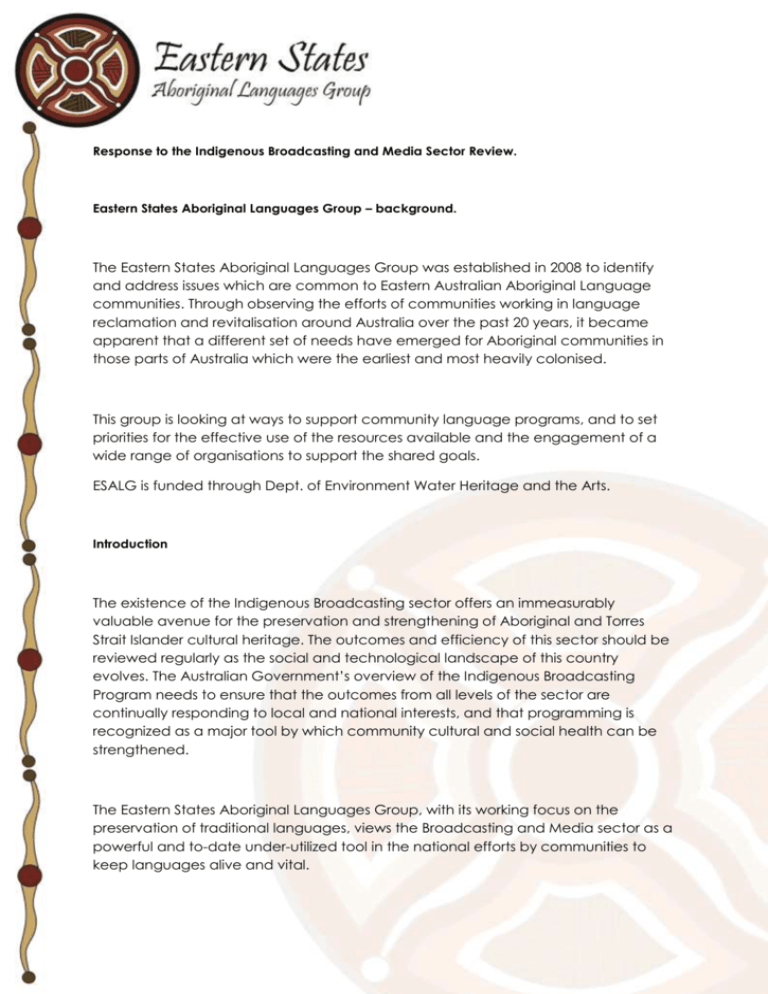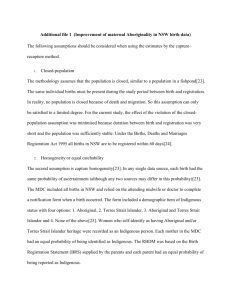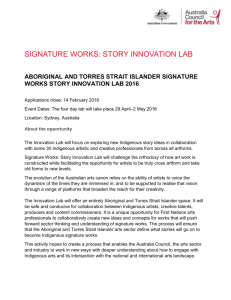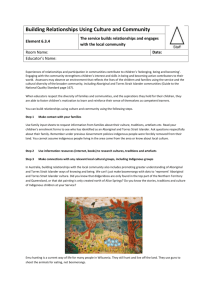Word - 2.1 mb
advertisement

Response to the Indigenous Broadcasting and Media Sector Review. Eastern States Aboriginal Languages Group – background. The Eastern States Aboriginal Languages Group was established in 2008 to identify and address issues which are common to Eastern Australian Aboriginal Language communities. Through observing the efforts of communities working in language reclamation and revitalisation around Australia over the past 20 years, it became apparent that a different set of needs have emerged for Aboriginal communities in those parts of Australia which were the earliest and most heavily colonised. This group is looking at ways to support community language programs, and to set priorities for the effective use of the resources available and the engagement of a wide range of organisations to support the shared goals. ESALG is funded through Dept. of Environment Water Heritage and the Arts. Introduction The existence of the Indigenous Broadcasting sector offers an immeasurably valuable avenue for the preservation and strengthening of Aboriginal and Torres Strait Islander cultural heritage. The outcomes and efficiency of this sector should be reviewed regularly as the social and technological landscape of this country evolves. The Australian Government’s overview of the Indigenous Broadcasting Program needs to ensure that the outcomes from all levels of the sector are continually responding to local and national interests, and that programming is recognized as a major tool by which community cultural and social health can be strengthened. The Eastern States Aboriginal Languages Group, with its working focus on the preservation of traditional languages, views the Broadcasting and Media sector as a powerful and to-date under-utilized tool in the national efforts by communities to keep languages alive and vital. Observations on current practices within the Broadcasting and Media Sector. In too many instances community broadcasting and media allocate little or no time to programs about or “In” Aboriginal and Torres Strait Islander languages. A large proportion of the content of this broadcasting is seen by community as fairly mainstream non – Indigenous programming. It is understandable that financial concerns impact on the selection of program delivery, particularly in television broadcasting and this explains in part the high proportion of regular non Indigenous content. There are however many examples of community radio in particular devoting regular timeslots to the promotion of languages, both currently and at times in the past. These include: Bourke 2CUZ fm. Weekly programming to teach local language. Radio Nambucca. Weekly program talking about the community language program. Brisbane 98.9 fm Regular reporting on national issues relating to languages and promotion of Indigenous music artists. Koori Radio Sydney, a comprehensive series featuring stories from language programs around Australia. These are examples of programs have been developed to fit to local needs and local interest and importantly, respond to the level of language knowledge available within the community at the time. Recommendations The Eastern States Aboriginal Languages Group would like to make the following recommendations in regard to this review. 1. That the Broadcasting and Media sector as a whole addresses the need to devote significant time and energy to supporting the use of Aboriginal and Torres Strait Islander languages, as is chartered in the aims of Indigenous Broadcasting Program. 2. That a comprehensive strategy is developed by the sector to meet this need. The strategy should be developed through collaboration between key media organisations with reference to significant language bodies. (National, Eastern States, State and Territory language organisations.) 3. That the strategy aims to provide examples and guides for a wide range of different program types. These should reflect the following points: For localised community broadcasting. The level of language knowledge within the local community for local program content. The range and diversity of local languages relevant to the target audience. The aspirations of local community language program managers supporting the appropriate content for programs. For national programming. Should promote the diversity and significance of the traditional languages of Australia to a national and international audience. Needs to reflect the goals and achievements of a broad range of community program types; To support innovation and artistic achievement incorporating traditional languages. 4. That the strategy reflects the directions of the National Indigenous Languages Policy. 5. That the strategy incorporates ways to link with other sectors who are already producing materials in and relevant to languages and finds ways to broadcast or promote these. This would include Languages, Education, Health, Environment and Justice. 6. It is also suggested that a portion of the funding provided to organisations under the Broadcasting Program be tied to outcomes described in a Languages/ Broadcasting Strategy. In this way the efforts of those organisations which implement language focused programming are recognized and supported. 7. That an active, effective and vocal peak body is essential for the dynamic delivery of services. The Eastern States Aboriginal Languages Group appreciates the opportunity to contribute to this discussion and would be pleased to take part in any future consultations that may result from the review. Contact Faith Baisden. Coordinator. Email faith@binabar.com. Ph. 07 32863965. M. 0417628437







